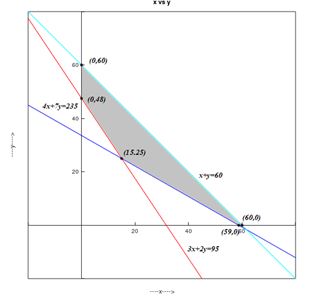
Animal Nutrition Kevin's dog Amadeus likes two kinds of canned dog food. Gourmet Dog costs 40 cents a can and has 20 units of a vitamin complex; the calorie content is 75 calories. Chow Hound costs 32 cents a can and has 35 units of vitamins and 50 calories. Kevin likes Amadeus to have at least 1175 units of vitamins a month and at least 2375 calories during the same time period. Kevin has space to store only 60 cans of dog food at a time. How much of each kind of dog food should Kevin buy each month to minimize his cost?
To solve: The given linear programming problem.
Answer to Problem 30AYU
Solution:
15 numbers of Gourmet Dog cans and 25 numbers of Chow Hound cans are to be purchased to minimize the cost.
Explanation of Solution
Given:
- The costs of Gourmet Dog can and Chow Hound Can are 40 cents and 32 cents respectively.
- The vitamin content in Gourmet Dog can and Chow Hound Can are 20 units and 35 units respectively.
- The calories provided by each Gourmet Dog can and Chow Hound Can are 75 units and 50 units respectively.
- The dog requires at least 1175 units of vitamin and 2375 calories a month.
- Only 60 can of dog food can be stored at a time.
Calculation:
Begin by assigning symbols for the two variables.
be the number of Gourmet Dog cans.
be the number of Chow Hound cans.
If be the total cost of buying cans for a month,
The goal is to minimize subject to certain constraints on and . Because and represents number of dog food cans, the only meaningful values of and are non-negative.
Therefore, .
From the given data we get,
Therefore, the linear programming problem may be stated as,
Minimize, .
Subject to,
The graph of the constraints is illustrated in the figure below.

The corner points are as follows:
| Corner points are | Value of objective function |
Therefore, 15 number of Gourmet Dog cans and 25 number of Chow Hound cans are to be purchased to minimize the cost.
Chapter 11 Solutions
Precalculus
Additional Math Textbook Solutions
Basic Business Statistics, Student Value Edition
Calculus: Early Transcendentals (2nd Edition)
Elementary Statistics
Pre-Algebra Student Edition
A First Course in Probability (10th Edition)
University Calculus: Early Transcendentals (4th Edition)
- Consider the function f(x) = x²-1. (a) Find the instantaneous rate of change of f(x) at x=1 using the definition of the derivative. Show all your steps clearly. (b) Sketch the graph of f(x) around x = 1. Draw the secant line passing through the points on the graph where x 1 and x-> 1+h (for a small positive value of h, illustrate conceptually). Then, draw the tangent line to the graph at x=1. Explain how the slope of the tangent line relates to the value you found in part (a). (c) In a few sentences, explain what the instantaneous rate of change of f(x) at x = 1 represents in the context of the graph of f(x). How does the rate of change of this function vary at different points?arrow_forward1. The graph of ƒ is given. Use the graph to evaluate each of the following values. If a value does not exist, state that fact. и (a) f'(-5) (b) f'(-3) (c) f'(0) (d) f'(5) 2. Find an equation of the tangent line to the graph of y = g(x) at x = 5 if g(5) = −3 and g'(5) = 4. - 3. If an equation of the tangent line to the graph of y = f(x) at the point where x 2 is y = 4x — 5, find ƒ(2) and f'(2).arrow_forwardDoes the series converge or divergearrow_forward
- Suppose that a particle moves along a straight line with velocity v (t) = 62t, where 0 < t <3 (v(t) in meters per second, t in seconds). Find the displacement d (t) at time t and the displacement up to t = 3. d(t) ds = ["v (s) da = { The displacement up to t = 3 is d(3)- meters.arrow_forwardLet f (x) = x², a 3, and b = = 4. Answer exactly. a. Find the average value fave of f between a and b. fave b. Find a point c where f (c) = fave. Enter only one of the possible values for c. c=arrow_forwardplease do Q3arrow_forward
- Use the properties of logarithms, given that In(2) = 0.6931 and In(3) = 1.0986, to approximate the logarithm. Use a calculator to confirm your approximations. (Round your answers to four decimal places.) (a) In(0.75) (b) In(24) (c) In(18) 1 (d) In ≈ 2 72arrow_forwardFind the indefinite integral. (Remember the constant of integration.) √tan(8x) tan(8x) sec²(8x) dxarrow_forwardFind the indefinite integral by making a change of variables. (Remember the constant of integration.) √(x+4) 4)√6-x dxarrow_forward
 Calculus: Early TranscendentalsCalculusISBN:9781285741550Author:James StewartPublisher:Cengage Learning
Calculus: Early TranscendentalsCalculusISBN:9781285741550Author:James StewartPublisher:Cengage Learning Thomas' Calculus (14th Edition)CalculusISBN:9780134438986Author:Joel R. Hass, Christopher E. Heil, Maurice D. WeirPublisher:PEARSON
Thomas' Calculus (14th Edition)CalculusISBN:9780134438986Author:Joel R. Hass, Christopher E. Heil, Maurice D. WeirPublisher:PEARSON Calculus: Early Transcendentals (3rd Edition)CalculusISBN:9780134763644Author:William L. Briggs, Lyle Cochran, Bernard Gillett, Eric SchulzPublisher:PEARSON
Calculus: Early Transcendentals (3rd Edition)CalculusISBN:9780134763644Author:William L. Briggs, Lyle Cochran, Bernard Gillett, Eric SchulzPublisher:PEARSON Calculus: Early TranscendentalsCalculusISBN:9781319050740Author:Jon Rogawski, Colin Adams, Robert FranzosaPublisher:W. H. Freeman
Calculus: Early TranscendentalsCalculusISBN:9781319050740Author:Jon Rogawski, Colin Adams, Robert FranzosaPublisher:W. H. Freeman
 Calculus: Early Transcendental FunctionsCalculusISBN:9781337552516Author:Ron Larson, Bruce H. EdwardsPublisher:Cengage Learning
Calculus: Early Transcendental FunctionsCalculusISBN:9781337552516Author:Ron Larson, Bruce H. EdwardsPublisher:Cengage Learning





